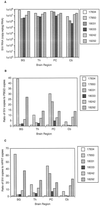High viral load in the cerebrospinal fluid and brain correlates with severity of simian immunodeficiency virus encephalitis
- PMID: 10559366
- PMCID: PMC113103
- DOI: 10.1128/JVI.73.12.10480-10488.1999
High viral load in the cerebrospinal fluid and brain correlates with severity of simian immunodeficiency virus encephalitis
Abstract
AIDS dementia and encephalitis are complications of AIDS occurring most frequently in patients who are immunosuppressed. The simian immunodeficiency virus (SIV) model used in this study was designed to reproducibly induce AIDS in macaques in order to examine the effects of a neurovirulent virus in this context. Pigtailed macaques (Macaca nemestrina) were coinoculated with an immunosuppressive virus (SIV/DeltaB670) and a neurovirulent molecularly cloned virus (SIV/17E-Fr), and more than 90% of the animals developed moderate to severe encephalitis within 6 months of inoculation. Viral load in plasma and cerebrospinal fluid (CSF) was examined longitudinally to onset of AIDS, and viral load was measured in brain tissue at necropsy to examine the relationship of systemic and central nervous system (CNS) viral replication to the development of encephalitis. In all animals, plasma viral load peaked at 10 to 14 days postinfection and remained high throughout infection with no correlation found between plasma viremia and SIV encephalitis. In contrast, persistent high levels of CSF viral RNA after the acute phase of infection correlated with the development of encephalitis. Although high levels of viral RNA were found in the CSF of all macaques (six of six) during the acute phase, this high level was maintained only in macaques developing SIV encephalitis (five of six). Furthermore, the level of both viral RNA and antigen in the brain correlated with the severity of the CNS lesions. The single animal in this group that did not have CNS lesions had no detectable viral RNA in any of the regions of the brain. The results substantiate the use of CSF viral load measurements in the postacute phase of SIV infection as a marker for encephalitis and CNS viral replication.
Figures





Similar articles
-
Relationship between viral load in blood, cerebrospinal fluid, brain tissue and isolated microglia with neurological disease in macaques infected with different strains of SIV.J Neurovirol. 2000 Jun;6(3):187-201. doi: 10.3109/13550280009015822. J Neurovirol. 2000. PMID: 10878709
-
Pathogenesis of SIV encephalitis. Selection and replication of neurovirulent SIV.Am J Pathol. 1997 Sep;151(3):793-803. Am J Pathol. 1997. PMID: 9284828 Free PMC article.
-
Cerebrospinal Fluid Biomarkers of Simian Immunodeficiency Virus Encephalitis : CSF Biomarkers of SIV Encephalitis.J Neuroimmune Pharmacol. 2016 Jun;11(2):332-47. doi: 10.1007/s11481-016-9666-9. Epub 2016 Apr 8. J Neuroimmune Pharmacol. 2016. PMID: 27059917 Free PMC article.
-
Monocyte/macrophage trafficking in acquired immunodeficiency syndrome encephalitis: lessons from human and nonhuman primate studies.J Neurovirol. 2008 Aug;14(4):318-26. doi: 10.1080/13550280802132857. J Neurovirol. 2008. PMID: 18780233 Free PMC article. Review.
-
Searching for clues: tracking the pathogenesis of human immunodeficiency virus central nervous system disease by use of an accelerated, consistent simian immunodeficiency virus macaque model.J Infect Dis. 2002 Dec 1;186 Suppl 2:S199-208. doi: 10.1086/344938. J Infect Dis. 2002. PMID: 12424698 Review.
Cited by
-
Non-Human Primate Models of HIV Brain Infection and Cognitive Disorders.Viruses. 2022 Sep 9;14(9):1997. doi: 10.3390/v14091997. Viruses. 2022. PMID: 36146803 Free PMC article. Review.
-
Neuropsychological test performance before and after HIV-1 seroconversion: the Multicenter AIDS Cohort Study.J Neurovirol. 2013 Feb;19(1):24-31. doi: 10.1007/s13365-012-0136-8. Epub 2012 Dec 11. J Neurovirol. 2013. PMID: 23229349 Free PMC article.
-
Monocyte mobilization, activation markers, and unique macrophage populations in the brain: observations from SIV infected monkeys are informative with regard to pathogenic mechanisms of HIV infection in humans.J Neuroimmune Pharmacol. 2012 Jun;7(2):363-71. doi: 10.1007/s11481-011-9330-3. Epub 2011 Dec 14. J Neuroimmune Pharmacol. 2012. PMID: 22167311 Review.
-
Neuroimmunity and the blood-brain barrier: molecular regulation of leukocyte transmigration and viral entry into the nervous system with a focus on neuroAIDS.J Neuroimmune Pharmacol. 2006 Jun;1(2):160-81. doi: 10.1007/s11481-006-9017-3. Epub 2006 Apr 13. J Neuroimmune Pharmacol. 2006. PMID: 18040782 Free PMC article. Review.
-
Thinking about HIV: the intersection of virus, neuroinflammation and cognitive dysfunction.Immunol Res. 2010 Dec;48(1-3):40-58. doi: 10.1007/s12026-010-8166-x. Immunol Res. 2010. PMID: 20725864 Review.
References
-
- Anderson M G, Hauer D, Sharma D P, Joag S V, Narayan O, Zink M C, Clements J E. Analysis of envelope changes acquired by SIVmac239 during neuroadaption in rhesus macaques. Virology. 1993;195:616–626. - PubMed
-
- Baskin G B, Murphey-Corb M, Martin L N, Soike K F, Hu F-S, Kuebler D. Lentivirus-induced pulmonary lesions in rhesus monkeys (Macaca mulatta) infected with simian immunodeficiency virus. Vet Pathol. 1991;28:506–513. - PubMed
-
- Brew B J, Pemberton L, Cunningham P, Law M G. Levels of human immunodeficiency virus type 1 RNA in cerebrospinal fluid correlate with AIDS dementia stage. J Infect Dis. 1997;175:963–966. - PubMed
Publication types
MeSH terms
Substances
Grants and funding
LinkOut - more resources
Full Text Sources
Other Literature Sources

